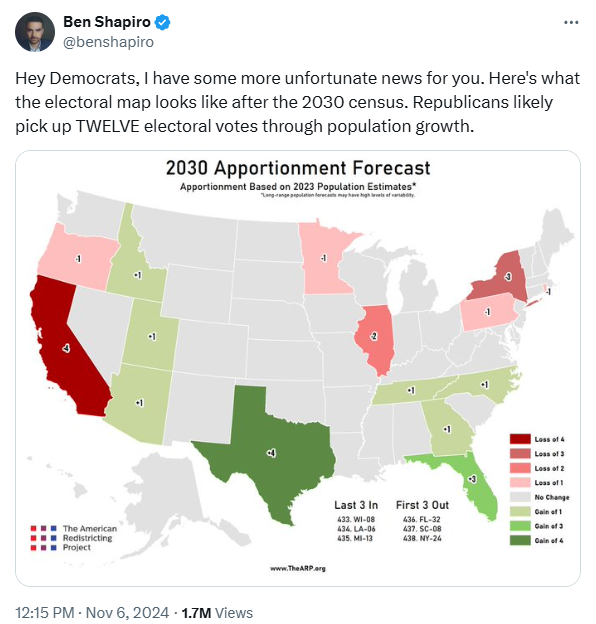Democrats are set to suffer more losses in the future following President-elect Donald Trump’s historic thumping of his rival, Vice President Kamala Harris. The upcoming 2030 Census apportionment forecast presents a challenging outlook for Democrats, as Republicans are poised to benefit from population shifts that could reshape the electoral landscape in their favor. The latest estimates suggest that states with Republican-leaning demographics are expected to gain a total of 12 electoral votes, potentially bolstering the GOP’s path to the White House in future elections.
According to 2023 population estimates from The American Redistricting Project, states that have leaned Republican in recent elections, such as Texas and Florida, are projected to gain seats in the House of Representatives, which will increase their electoral votes. Texas, in particular, is forecasted to gain an impressive four seats due to its rapid population growth, while Florida is expected to add two more. In contrast, traditional Democratic strongholds like California, New York, and Illinois are projected to lose seats because of declining populations. California is on pace to lose four seats, New York two, and Illinois one.

According to the forecast, the last states to gain or lose a seat included Wisconsin, Louisiana, and Michigan on the gain side, while Florida’s 32nd seat, South Carolina’s 8th, and New York’s 24th are projected to be the first three out. The apportionment forecast carries significant implications for both parties, but particularly for Democrats. Losing seats in states like California and New York not only decreases their electoral vote count but also diminishes their influence in Congress. States that heavily lean Democratic typically have a strong urban voter base, but population declines in these areas could present greater challenges for the party in securing a majority.
Texas’s four-seat gain and Florida’s two-seat gain represent a significant shift in favor of Republicans, contributing valuable electoral votes that could influence future elections. For the GOP, an increased electoral count in those states and other red enclaves will strengthen their position in the Electoral College, providing Republican candidates with an advantage in tight races.
Trump achieved the most improbable comeback in American political history on Tuesday night, likely securing a return trip to the White House by overcoming a relentless wave of opposition from the media, Big Tech, and Democrats that extended from courtrooms to social media platforms. Trump was set to become only the second American president to serve non-consecutive terms, but he did so against far greater odds than Grover Cleveland did a century earlier—having been impeached and acquitted twice, indicted four times, facing two assassination attempts, and enduring an unprecedented barrage of legal challenges.
More significantly than his personal journey to becoming President-Elect 47, Trump orchestrated a historic political realignment, one that is deeper and more pervasive than his surprising 2016 victory, as he successfully attracted long-standing constituencies away from the Democratic Party, Just the News reported. The electoral shift may soon be referred to as D-Exit, the American equivalent of Great Britain’s Brexit departure from the European Union, as Black males, Hispanic voters, and young voters rallied more strongly behind Trump and were less enthusiastic about Harris compared to Joe Biden or Barack Obama. Additionally, Arab and Muslim voters also showed diminished support for Harris.
Disclaimer: This article may contain commentary which reflects the author’s opinion.

